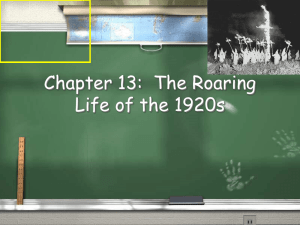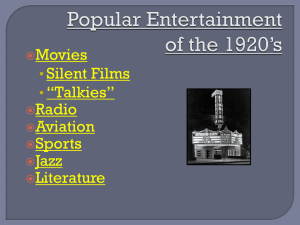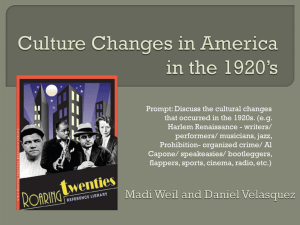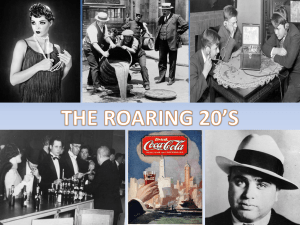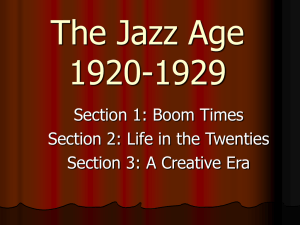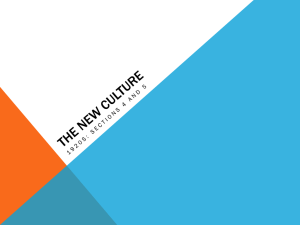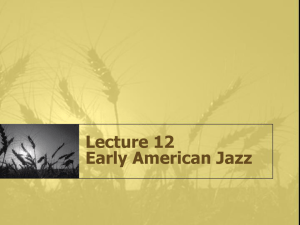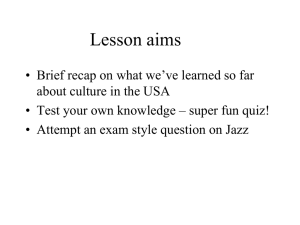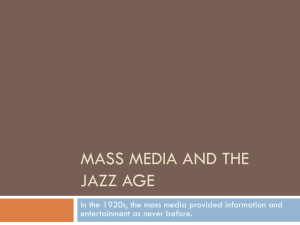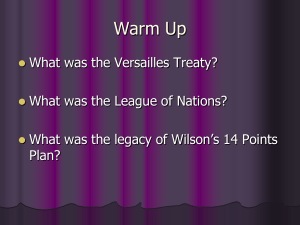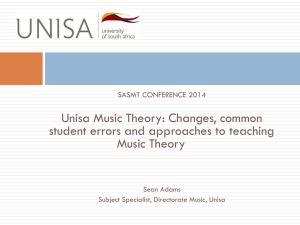Chapter 13: Powerpoint
advertisement
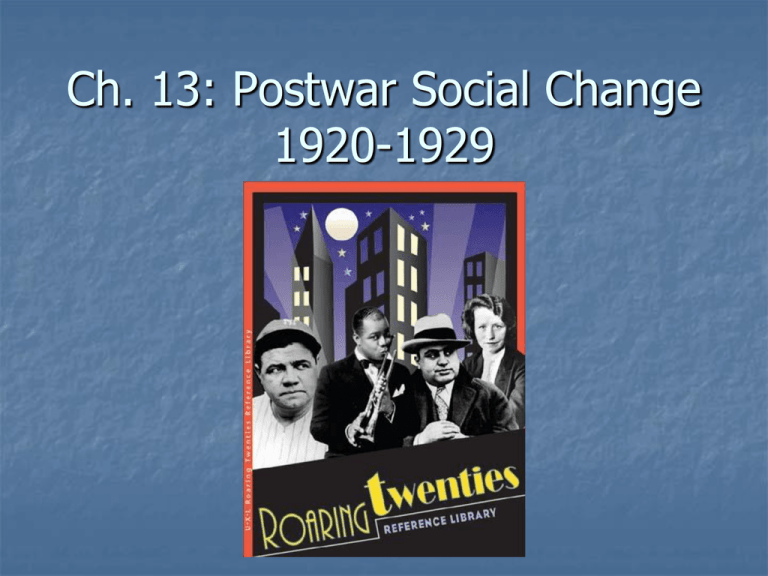
Ch. 13: Postwar Social Change 1920-1929 Section 1: Society in the 1920s The 1920s marked a period of rapid social change in the United States. Many changes challenged cultural norms and values of the day. Women’s Changing Roles Many of the changes in the era revolved around women. During WWI, many women entered the work force. The Nineteenth Amendment, adopted in 1920, granted women the right to vote. Flappers A new type of young women: rebellious, energetic, bold, fun-loving, and risqué were known as flappers. Flappers began wearing shorter hair, shorter dresses, and heavy makeup. Flappers challenged traditional values, with new styles of dress and dancing. Some drank alcohol or smoked in public. Flappers Flappers offended many people. The New York Times wrote in July 1920, “the American woman… has lifted her skirts far beyond any modest limitation.” Between 1913 and 1928, the average amount of fabric used to make a woman’s outfit went from 19.5 yards to 7 yards. Women Working and Voting Increasingly, women entered the work force. Most working women were young and single, but by 1930, 29% of all working women were married. Businesses remained prejudiced against women seeking professional jobs. Women Voting As of 1920, women could vote in all elections. Early on, most women either did not exercise their right to vote or voted in patterns similar to men. As the 1920s progressed, more women began to vote. Jeannette Rankin of Montana won election to the U.S. House of Representatives. Became first women elected to Congress. Americans on the Move The 1920s magnified the gap between rural and urban society. The industrial economy of the city thrived during the 20s. 6 million people moved from rural to urban areas. Urban Migration Education increased in urban settings In 1920 there were 2.2 million high school students, in 1930 there were 4.4 million. Youth in rural areas were needed for farm labor, urban youth were more free to attend school into their teenage years. Rural and urban America were divided on cultural issues. Many rural Americans viewed the cultural changes occurring in cities as immoral, dangerous, or corrupt. African American “Great Migration” Many African Americans moved from the South to northern cities, the “Great Migration.” 2 million African Americans moved to northern cities from 1910-1930. Played a significant role in the cultural changes occurring in urban areas. Growth of the Suburbs As cities grew and transportation improved, many Americans began to move into the suburbs. Trolleys were replaced by buses in many areas and automobiles became more affordable. Example: in NYC, Manhattan’s population decreased, but the suburb of Queens’ population doubled. Charles Lindbergh Charles Lindbergh was among several of the idolized heroes of the 1920s. In 1927, Lindbergh became the first person to fly nonstop from New York to Paris. Praised not only for his flying achievements but his steady, down-to-earth character. Amelia Earhart In 1932, Amelia Earhart became the first woman to fly solo across the Atlantic. She set other aviation records, including a solo flight from Hawaii to California. In 1937, while attempting to fly around the world, she went missing after completing 2/3 of the trip. Sports Heroes Spectator Sports greatly increased in popularity in the 1920s. Heavy commercialization increased both the audience and revenue of athletics, turning sports into big business. Jack Dempsey Famous boxer, Jack Dempsey, beat Georges Carpentier in 1921 to become the world heavyweight champion. The fight broke the record for ticket sales, earning $1 million. Dempsey became popular around the country. Jim Thorpe Jim Thorpe was and Olympic gold medalist in the decathlon and pentathlon. He played professional baseball and went on to be a professional football star in the 1920s. An American Indian George Herman “Babe” Ruth Most famous of all athletes during the 1920s, and possibly all U.S. History, was “Babe” Ruth. Ruth hit 714 career home runs, a record unbroken for 40 years. Beyond achievements, Ruth was famous for his bold, charismatic personality. Women in Sports People from all aspects of life began to participate in sports, including women. Hazel Wightman and Helen Wills were Olympic and Wimbledon tennis stars. Gertrude Ederle was an Olympic freestyle swimming champion. In 1926, Ederle became the first woman to swim across the English Channel, 35 miles long. Section 2: Mass Media and Jazz Age 1920s were greatly shaped by the introduction of mass media and the Jazz Age Mass Media New and improved methods of film, print, and broadcasting created the birth of mass media, communication with large audiences. Film and radio broadcasting became more popular during the era. Movies Between 1910 to 1930 the number of movie theaters rose from 5,000 to 22,500. Moviemaking became the fourth largest business in the country by 1929. Hollywood became moviemaking capital of America. Early movies were silent, The Jazz Singer becomes the first successful sound film, a “talkie”. Newspapers and Magazines Newspaper print and circulation roughly doubled between 1914 and 1927. Profits, not quality, drove newspaper publishers. Tabloids, papers with large headlines, few words and many pictures, became popular. William Randolph Hearst said he wanted 90% entertainment, 10% information. Magazines also rose in popularity Saturday Evening Post, Reader’s Digest, and Time Radio In 1920, engineer Frank Conrad set up a radio transmitter in his garage and began sending recorded music and baseball scores over the radio. Response was so positive it became the first commercial radio station, Pittsburgh KDKA. By 1922, there were more than 500 stations on the air. The Jazz Age “(Jazz was) an expression of the times, of the breathless, energetic, superactive times in which we are living.” -Leopold Stokowski “Jazz objectifies America… a group of people can come together and create art, improvised art, and can negotiate their agendas with each other.” -Wynton Marsalis Jazz Arrives Jazz music grew out of African American music of the South, a mixture of ragtime and blues. Jazz becomes a nationwide craze. Young people loved dancing to jazz music, causing some opposition to the new sound. The 1920s is sometimes referred to as the Jazz Age Jazz Clubs and Dance Halls Harlem becomes a popular Jazz area, with roughly 500 jazz clubs. Many upscale clubs were attended primarily by wealthy whites, but the jazz was played almost exclusively by African Americans. Most popular of jazz dance forms was “the Charleston”, a wild, reckless dance full of kicks and twists and pivots. Louis Armstrong Most important and influential figure in Jazz history. Grew up in New Orleans, where he learned to sing and play trumpet. His skill, improvisation, showmanship, and new “scat” singing made him a huge hit. “Duke” Ellington Edward Kennedy “Duke” Ellington performed in NYC. “Duke” was a pianist, band leader, an arranger, and a composer. Wrote over a thousand pieces in his career. The Jazz Spirit Jazz spirit ran through all the arts of the 1920s. People spoke of “jazz poetry” or “jazz painting”. More than a genre of music, “jazz” became an identity and characteristic. Painting Georgia O’Keeffe painted naturalistic scenes like flowers, landscapes, and oceans. Literature Sinclair Lewis- attacked American society through his writings. “savorless people, gulping tasteless food, and sitting afterward, coatless and thoughtless, in rocking-chairs prickly with inane decorations, listening to mechanical music, saying mechanical things about the excellence of Ford automobiles, and viewing themselves as the greatest race in the world.” –Sinclair Lewis, Main Street (1920) Eugene O’Neill- play writer; wrote dark, poetic tragedies. The Lost Generation Right: Hemingway Many writers found postwar America materialistic, and unintellectual. These writers and artists left the U.S. for Europe, many in Paris, France, where they produced many of their classics. Coined a “Lost Generation” of writers, the group included E.E. Cummings, Ernest Hemingway, and F. Scott Fitzgerald. The Harlem Renaissance Harlem, NYC served not just as a center for jazz music, but also gave birth to an African American literary, artistic, and cultural awakening. This movement was called the Harlem Renaissance. Renaissance is French for rebirth. Langston Hughes Most famous of these African American writers was poet Langston Hughes. A Dream Deferred What happens to a dream deferred? Does it dry up like a raisin in the sun? Or fester like a sore-And then run? Does it stink like rotten meat? Or crust and sugar over-like a syrupy sweet? Maybe it just sags like a heavy load. Or does it explode? Section 3: Cultural Conflicts A period of rapid cultural change, the 1920s often sparked significant conflict between people with different values, morals, and beliefs. Prohibition In 1920, the 18th Amendment, a prohibition of the production and consumption of alcohol, took effect. Prohibitionists sought to… Eliminate drunkenness and abuse Get rid of salons, where gambling and prostitution also thrived Prevent absenteeism and on-the-job accidents stemming from drunkenness Prohibition Despite the new Amendment, the prohibition was largely ignored. Even President Harding continued to drink alcohol. Accentuated the contrast between rural and urban moral values. 95% of Kansans obeyed the law 5% of New Yorkers obeyed the law Bootlegging Bootleggers was the name given to those who produced and/or supplied alcohol illegally. Speakeasies were bars that operated illegally. Speakeasies thrived in the cities The state of Massachusetts has 1,000 salons before the prohibition, but had 4,000 speakeasies in Boston alone during it. Organized Crime Bootlegging operations led to other forms of illegal activity, gambling, prostitution, and racketeering (bribing police and government to ignore illegal activities) Al Capone- the most notorious of these new gangsters wielded enormous power. Operating in Chicago, Capone made $60 million a year from bootlegging alone. Finally was convicted of income-tax evasion and sent to prison in 1931. Religious Fundamentalism Many religious Americans were concerned about modern society’s questioning of scriptural accuracy. Published 12 pamphlets called The Fundamentals, and soon became known as religious fundamentalists. Major belief being the inerrancy of scripture Evolution and the Scopes Trial Fundamentalists denounced evolutionary theory. Tennessee banned teaching evolution in schools. John T. Scopes, a science teacher, taught evolution anyway and was arrested, his highly publicized trial is remembered as the Scopes Trial. Scopes Trial William Jennings Bryan, a fundamentalist, volunteered to prosecute Scopes. Clarence Darrow was the defendant. Scopes was found guilty but the case highlighted a very distinct national clash of values, pitting science against faith. Racial Conflict: Revival of the Klan During Reconstruction, the Ku Klux Klan was virtually wiped out. In 1915, a Methodist preacher from Atlanta revived the organization. By 1922, Klan membership had grown to 100,000, in 1924, it had grown to 4 million. The “new” KKK hated not just African Americans, but any “unAmerican” groups: Jews, Catholics, and immigrants. Marcus Garvey Marcus Garvey was born in Jamaica and moved to NYC in 1916. Garvey founded the Universal Negro Improvement Association (UNIA). Promoted black self-pride and power, helped set up blackowned businesses. Started a “back to Africa” movement, encouraged blacks to return to Africa to create a selfgoverning nation. Garvey’s Movement Garvey was not embraced by all African Americans, including W.E.B. Du Bois who disagreed with Garvey’s call for a separation of races. Garvey collected $10 million for a steamship company to take his followers back to Africa. Corruption and mismanagement ended the shipping line and placed Garvey in prison for mail fraud in 1925.
